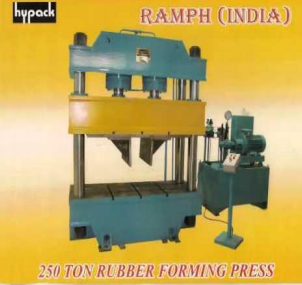Rubber Forming Machine Manufacture: An Overview
Rubber forming machines are critical in the manufacturing sector, particularly in industries requiring high-precision rubber components. These machines are designed to process raw rubber into usable products, ranging from simple rubber gaskets to complex automotive parts. The manufacture of rubber forming machines involves a combination of mechanical engineering, materials science, and precision manufacturing processes. This article provides an in-depth look into the manufacturing process, the key components of rubber forming machines, and the industries that rely on these essential tools.
The Manufacturing Process
The manufacture of rubber forming machines begins with the design phase. Engineers create detailed blueprints that outline the specifications, dimensions, and capabilities of the machine. The design must account for the types of rubber to be processed, the shapes and sizes of the products to be formed, and the production capacity required by the end user. This phase involves collaboration between mechanical engineers, materials scientists, and sometimes, end-users to ensure that the machine will meet specific needs.
Once the design is finalized, the production process starts with the selection of materials. High-quality steel and aluminum alloys are typically used for the machine's frame and components due to their durability and resistance to wear. The machine's molds, which determine the shape of the final rubber products, are usually made from hardened steel or, in some cases, special alloys that offer high thermal conductivity and resistance to corrosion.
The next step is the machining of these materials into the various components of the rubber forming machine. Precision is crucial at this stage, as even the smallest deviation from the design specifications can lead to defects in the final product. Advanced CNC (Computer Numerical Control) machines are often employed to ensure the accuracy and consistency of the components. These machines are capable of producing complex shapes with high precision, which is essential for the intricate molds used in rubber forming.
After machining, the components are assembled into the rubber forming machine. This process involves fitting together the machine's frame, installing the molds, and integrating the hydraulic or pneumatic systems that will drive the rubber forming process. Quality control is a critical part of the assembly process. Each component and sub-assembly is rigorously tested to ensure it meets the required specifications. Any defects detected at this stage are corrected before the machine proceeds to the final assembly.
Once the assembly is complete, the machine undergoes a series of tests to ensure it operates correctly. These tests include running the machine with different types of rubber, adjusting the pressure and temperature settings, and evaluating the quality of the formed rubber products. The machine's control systems, which may include PLCs (Programmable Logic Controllers) or computer interfaces, are also tested to ensure they provide the necessary precision and repeatability for the manufacturing process.
Key Components
Rubber forming machines consist of several key components, each playing a crucial role in the overall operation. The mold is perhaps the most important component, as it determines the shape of the final product. These molds are precision-engineered and often custom-made to meet the specific needs of the customer.
The heating system is another critical component. Rubber forming requires precise temperature control to ensure the material is pliable enough to be shaped without degrading its properties. The heating system, which may include electric heaters or steam systems, must be capable of maintaining consistent temperatures throughout the process.
The hydraulic or pneumatic system provides the force necessary to press the rubber into the mold. This system must be capable of delivering high pressure with precision control to ensure that the rubber forms correctly without defects. Modern machines often include sophisticated control systems that allow operators to adjust the pressure, temperature, and timing of the forming process to achieve optimal results.
Applications and Industries
Rubber forming machines are used in a wide range of industries, including automotive, aerospace, healthcare, and consumer goods. In the automotive industry, these machines produce critical components such as seals, gaskets, and hoses. In the aerospace industry, rubber forming machines are used to create parts that require high precision and durability, such as seals and vibration dampers. The healthcare industry relies on these machines to manufacture rubber components used in medical devices and equipment.
In conclusion, the manufacture of rubber forming machines is a complex process that requires a combination of precision engineering, advanced materials, and quality control. These machines play a crucial role in various industries, enabling the production of high-quality rubber components that meet the stringent requirements of modern manufacturing. As technology advances, the capabilities of rubber forming machines continue to improve, allowing manufacturers to produce increasingly complex and precise rubber products.
